
Publications
Since 2013, the CARGC Press imprint has published CARGC Papers, CARGC Briefs, and special issues of scholarly journals with partners like International Journal of Communication and Communication and the Public. Since September 2022, CARGC has launched the Global Media & Communication podcast series in partnership with New Books Network.
We envision our growth to include publishing original and translated books for teaching, research, and practice. In addition to publishing and promoting CARGC research, we seek to understand technologically and economically driven changes to knowledge production, dissemination, and access worldwide. CARGC Press publications offer original and timely contributions to pressing issues in global communications such as refugee mobile media practices, street art on the U.S.-Mexico border, rural communication in the U.S., and hacktivism in Turkey, authored by a range of global media scholars from CARGC Undergraduate Fellows to world renowned scholars such as Saskia Sassen and Arjun Appadurai.
Books & Articles
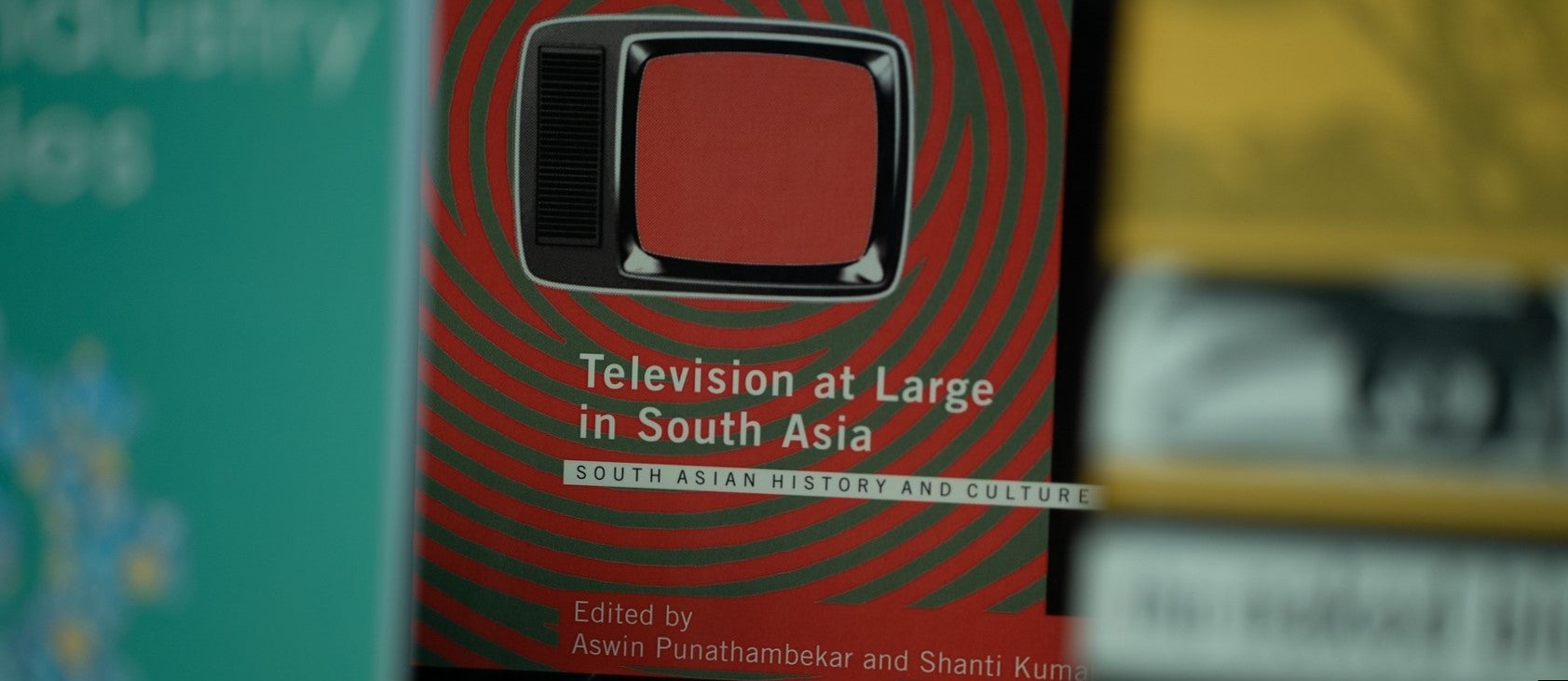
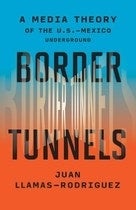
Juan Llamas-Rodriguez, University of Minnesota Press, 2023
Border tunnels at the U.S.–Mexico border are ubiquitous in news, movies, and television, yet, because they remain hidden and inaccessible, the public can encounter them only through media. Analyzing the technologies, institutional politics, narrative tropes, and aesthetic decisions that go into showing border tunnels across multiple forms of media, Juan Llamas-Rodriguez argues that we cannot properly address border issues without attending to—and fully understanding—the fraught relationship between their representation and reality.
View "Border Tunnels: A Media Theory of the U.S.–Mexico Underground"
Aswin Punathambekar, International Journal of Cultural Studies, 2022
This article analyses the unfolding impact of social media platforms on the politics of race, ethnicity, and gender in the UK. Revisiting Stuart Hall's foundational work on ‘new ethnicities’ and building on recent critiques of anti-racist struggles premised on mainstream media visibility and recognition, we explore how British South Asian women are navigating opportunities opened up by the digitalization of media industries. First, we examine how an interlocking set of shifts involving social media, techniques of self-making, and media industry logics has sparked the curation of ethnicities that challenge dominant ideas of Britishness and cultural citizenship. We then show that their success hinges on performing two forms of labour: crafting brand-ready representations that satisfy the media industries’ diversity mandates and, at the same time, subsuming their religious and ethnic identities into a picture of entrepreneurial womanhood that resonates with the logics of popular feminism.
Jing Wang, New Media & Society, 2022
How do Chinese Muslims have their own voices heard under China’s tightening online censorship amid a global health crisis like COVID-19? Based on 13-month ethnographic fieldwork, this article examines the active participation and creative use of digital media by Chinese Muslims during the pandemic. This study uses multi-sited ethnography (MSE) and digital ethnography to identify major features of networked Islamic counterpublic in China. It shows how Chinese Muslims creatively blend Islamic discourses of hygiene, scientific discourse, official regulations, and global discourses of public health through digital media. It also examines how Chinese Muslims selectively use digital platforms to cultivate Islamic ethics and strengthening global connections to Muslim world both online and offline. Furthermore, this study shows how resilient the networked Islamic counterpublic in China has been in terms of strategically voicing dissent in the shadows of anti-Muslim sentiments and state policies during a major global pandemic of our time.
Jing Wang, Made in China, 2022
In the spring of 2022, two years after the Wuhan lockdown of 2020, the megacity of Shanghai—an urban agglomeration that is home to more than 26 million people—came under lockdown. Once acclaimed by officials and experts as one of China’s best-managed cities during the Covid-19 pandemic, Shanghai shocked the world with its tough lockdown policies. Once proud of being a ‘magical metropolis’ (魔都), the city experienced one of the most surreal, tragic moments in its history.
Read "Lockdown Sound Diaries: Podcasting and Affective Listening in the Shanghai Lockdown"
Aswin Punathambekar and Padma Chirumamilla, Television & New Media, 2022
This article engages with the history of television and television studies in South Asia to reflect on how “media” can be re-imagined as an object of analysis and critique. Questioning the analytic primacy accorded to film, we develop the concept of televisual drag and argue that bringing television to the fore can reveal different temporalities, modalities, and logics for the evolution of South Asian screen media, both in their past forms and current constitution. We critically engage with recent studies—of Indian women filmmakers, Pakistani comic shows and YouTube videos, and small-town video circulation in India—to illuminate the currents of televisual drag at work in contemporary media scholarship. We conclude by reflecting how how televisual drag might be a critical method for drawing insights from media histories, practices, and environments that do not or will not follow an easily comprehensible path toward a seemingly inevitable digital horizon.
Read "Televisual Drag: Reimagining South Asian Film and Media Studies"
Hatim El-Hibri, Duke University Press, 2021
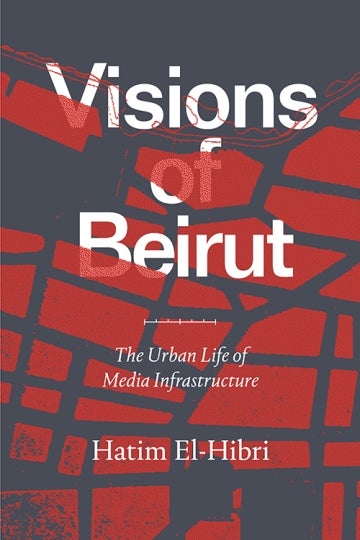
In Visions of Beirut, Hatim El-Hibri explores how the creation and circulation of images have shaped the urban spaces and cultural imaginaries of Beirut. Drawing on fieldwork and texts ranging from maps, urban plans, and aerial photographs to live television and drone-camera footage, El-Hibri traces how the technologies and media infrastructure that visualize the city are used to consolidate or destabilize regimes of power. Throughout the twentieth century, colonial, economic, and military mapping projects helped produce and govern Beirut's spaces. In the 1990s, the imagery of its post-civil war downtown reconstruction cast Beirut as a site of financial investment in ways that obscured its ongoing crises. During and following the 2006 Israel/Hizbullah war, Hizbullah's use of live television broadcasts of fighting and protests along with its construction of a war memorial museum at a former secret military bunker demonstrate the tension between visualizing space and the practices of concealment. Outlining how Beirut's urban space and public life intertwine with images and infrastructure, El-Hibri interrogates how media embody and exacerbate the region's political fault lines.
View "Visions of Beirut: The Urban Life of Media Infrastructure"
Jinsook Kim, JCMS: Journal of Cinema and Media Studies, 2021
This article examines the convergence of online and offline political action in the form of “sticky note activism” following the 2016 Gangnam Station murder in South Korea, which involved the posting of handwritten sticky notes in public spaces and the dissemination of images of the notes through digital media. I argue that, as an alternative feminist media practice, sticky note activism has helped catalyze the formation of affective counterpublics by mobilizing women’s affect, challenging dominant narratives about the misogynistic murder, and, thereby, broadening the context for the collective articulation of new feminist voices and practices.
Samira Rajabi, Rutgers University Press, 2021
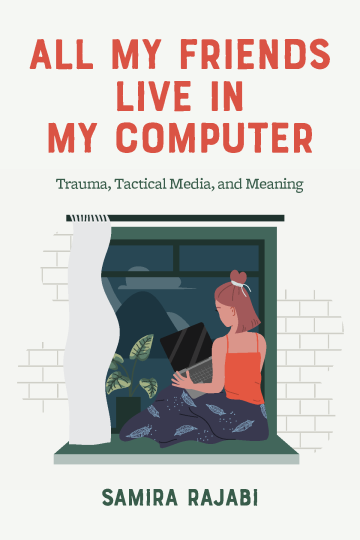
All My Friends Live in My Computer combines personal stories, media studies, and interdisciplinary theories to examine case studies from three unique parts of society. From illness narratives among breast cancer patients to political upheaval among Iranian-Americans, this book examines what people do when they go online after they have suffered a trauma. It offers in-depth academic analysis alongside deeply personal stories and case studies to take the reader on a journey through rapidly changing digital/social worlds. When people are traumatized, their worlds stop making sense, and All My Friends Live in My Computer explores how everyday people use social media to try and make a new world for themselves and others who are suffering. Through its attention to personal stories and application of media theory to new contexts, this book highlights how, when given the tools, people will make meaning in creative, novel, and healing ways.
View "All My Friends Live in My Computer: Trauma, Tactical Media, and Meaning"
Woori Han, Korean Journal of Communication & Information Studies, 2021
This paper explores how biopolitics in the pandemic crisis foregrounds gay men’s bodies and their sexual practices as a problem in a way that reinforces a heteronormative, individualist, development subjectivity as norms. I analyze public and popular discourses surrounding the Itaewon incident where gay clubbers were blamed for the second wave of Covid19 virus mass infection and which triggered homophobia in May 2020. The hegemonic discourses depict Korean gays as ahistorical and disrupting the linear narrative of national development and as irresponsibly seeking personal sexual desires outside the home. These discourses are deployed to contribute to normative ideas of national development, heterosexual family-centered intimacy, safe home, and the fantasy of a self-sufficient self. The paper also shows how queer activists in response to such biopolitical governance of queer bodies and sexual practices produce alternative discourses and organize counter-practices. Illustrating how queer movements shamelessly advocate and historicize their sexual practices as a way to create and sustain sociality and cultivate collective care for others, the paper concludes these practices could challenge the operation of biopolitics and enable us to reimagine a politics of possibility.
Read "Reconfiguring the Pandemic Norms through Sexuality and Imagining Queer Collective Care"
Lauren Bridges, Information, Communication & Society, 2021
Amazon’s Ring relies on infrastructural obfuscation to hide their infrastructures through urban camouflage (as doorbells, floodlights, sensors) while simultaneously expanding the carceral state and extending the industrial police-surveillant state. Through a critical analysis of the Ring surveillant assemblage, this paper reveals the way Ring and its associated apps produce fear and paranoia of the racialized Other, promote community buy-in that more surveillance will improve safety, while obscuring private partnerships with local law enforcement. I argue Ring cannot be viewed in isolation from its entangled corporate owner, Amazon, which relies on an ever-expanding infrastructural network, including surveillance of their highly prized package delivery service. Ring is more than individual community members installing doorbells with cameras that extend beyond their property into public space; it is the blurring of boundaries between police work and civilian surveillance, the reliance on obscured digital infrastructures that hide to whom and what users are connecting when they install a Ring device, and the expansion of Amazon’s vast infrastructural power. By recentering critique on the infrastructural backbone, made up of discourses and fixtures, this paper argues for the need for infrastructural accountability from companies such as Amazon, who not only profit from fear, but actively reproduce structural violence through their data infrastructures.
Read "Infrastructural obfuscation: unpacking the carceral logics of the Ring surveillant assemblage"
Ayesha Omer, Cultural Studies, 2021
This paper analyzes the formation of coal energy infrastructure in Pakistan’s Thar Desert as part of the China–Pakistan Economic Corridor. This infrastructure comprises an open pit coal mine and thermal power plant that traverses indigenous lifeworlds. My analysis takes up the subterranean matter of Thar’s Desert – the coal, the sand, the water – and its related social and ecological contexts. I show that decades of technological processes of tests, drilling, chemical analyses, surveys, simulations, and maps of coal, water, and sand have yielded ‘coal data’ that mediates Thar’s ancient lifeworlds in a singular relation to its coal deposit. Coal data, the mediated representations of subterranean coal, forms the very basis upon which coal extraction is performed and global energy infrastructures are advanced. The Sindh Engro Coal Mining Company (SECMC), a joint venture of Pakistani and Chinese actors financed by Chinese state-capital, repeatedly presents Thar’s land as coal data. Through the kinds of cultural authority granted to data as representations of technological objectivity, the SECMC is able to claim coal infrastructure as the foundation for a national energy future of Pakistan. Despite the SECMC’s efforts to overlay the land with mediated coal data, Thar’s indigenous villagers have enacted a historic protest and long march, including hunger strikes with unprecedented participation by women, and filed a case in the High Court in order to protest the poisoning of their agricultural farmlands and the eventual displacement from their homes. Through these mediated constructions of Thar’s land as coal data, and the indigenous movements against coal mining, the ground of the Thar Desert is being reconfigured and reproduced as – what I call – a coal ground.
Jinsook Kim, Korea Journal, 2021
This paper provides an overview of the ways in which feminist activism has, since 2015, gained new momentum in South Korea in terms of its scope, reach, and range of agendas. Building on existing scholarly discussions of feminist movements and gender politics, I first situate the resurgence of feminism within the broader historical and socio-political context of Korean society, including the diversification of social movements generally in post-authoritarian Korea, women’s precarious status, and the rise of misogyny. I then discuss the main characteristics of feminist activism on digital media and their implications, in particular, the broad range of feminist subjects, the extension of sites for and methods of struggle, and the emergence and centering of gendered issues within digital environments. Lastly, I assess the limitations of the term “young young feminist” and the diverse politics and controversies associated with contemporary feminist activism, with a focus on the critiques of raetpem (self-identified ‘radical feminists’). Te paper concludes with an argument for intersectional and transnational feminism and suggestions for future research into feminist activism.
Aswin Punathambekar and Sriram Mohan, BioScope: South Asian Screen Studies, 2021
In January 2019, Indian yoga guru and businessman Swami Ramdev filed a defamation suit in the Delhi High Court seeking global injunctions against videos posted about him by users on Facebook, Google Plus, YouTube and Twitter. The judgement in the case opened with this statement – ‘for the sake of convenience, the defendants and their various websites, social media platforms, URLs, weblinks etc. are collectively referred to as “platforms”’ (Swami Ramdev & ANR versus Facebook, Inc. & ORS., 2019; emphasis ours). It was a striking illustration of the extent to which the term ‘platform’ has come to stand in for an entire digital media ecology: massive tech companies like Facebook, specific platforms like YouTube, web-based protocols and a wide range of user practices across this terrain. While the slipperiness of the term ‘platform’ is often appropriated by digital media companies to evade public oversight and stringent regulation, that same slipperiness was being deployed against them by Ramdev’s attorneys.
Daniel Herbert, Amanda D. Lotz, Aswin Punathambekar, Wiley, 2020
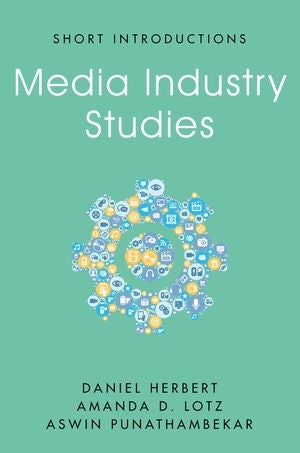
The study of media industries has become a thriving subfield of media studies. It already comprises a diverse intellectual history, a range of fascinating questions and topics, and many theoretical and methodological frameworks.
Media Industry Studies provides the roadmap to this vibrant area of study. Blending a comprehensive overview of foundational literature with an examination of the varied scales and sites media industry studies have considered, the book explores connections among research questions, topics, and methodologies. It includes examples from many media industries – film, television, journalism, music, games – and incorporates emerging scholarship considering the industrial contexts of social and internet-distributed media.
Offering an account of the intellectual traditions and approaches that have defined the subfield to date, Media Industry Studies is an indispensable resource for upper-level undergraduates, postgraduates, and scholars.
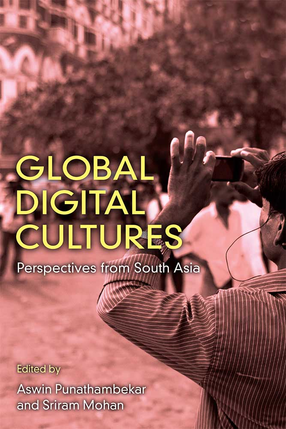
Edited by Aswin Punathambekar and Sriram Mohan, University of Michigan Press Ebook Collection, 2019
Digital media histories are part of a global network, and South Asia is a key nexus in shaping the trajectory of digital media in the twenty-first century. Digital platforms like Facebook, WhatsApp, and others are deeply embedded in the daily lives of millions of people around the world, shaping how people engage with others as kin, as citizens, and as consumers. Moving away from Anglo-American and strictly national frameworks, the essays in this book explore the intersections of local, national, regional, and global forces that shape contemporary digital culture(s) in regions like South Asia: the rise of digital and mobile media technologies, the ongoing transformation of established media industries, and emergent forms of digital media practice and use that are reconfiguring sociocultural, political, and economic terrains across the Indian subcontinent. From massive state-driven digital identity projects and YouTube censorship to Tinder and dating culture, from Twitter and primetime television to Facebook and political rumors, Global Digital Cultures focuses on enduring concerns of representation, identity, and power while grappling with algorithmic curation and data-driven processes of production, circulation, and consumption.
View "Global Digital Cultures: Perspectives from South Asia"
Donatella Della Ratta, Pluto Press, 2018
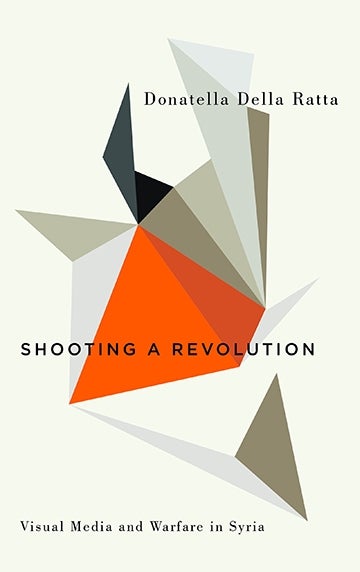
From ISIS propaganda videos to popular regime-backed soap operas and digital activism, the Syrian conflict has been profoundly affected by visual media. But what are the aesthetic, political, and material implications of this disturbing collusion between war and digital culture? Drawing on a decade of ethnographic research conducted in Syria and neighboring countries, Donatella Della Ratta examines here how the networked age shapes contemporary warfare, from conflict on the ground to the performance of violence on the screen. Her findings present a stark parallel to the digital democracy offered by techno-utopians, delving into the dark side of web 2.0 practices, where visual regimes of representation and media production are put in service of modes of destruction. A vivid account of the politics of Syria’s visual media, from commercial television to citizen journalism and Daesh propaganda, Shooting a Revolution offers fascinating insight into the media’s role in transforming conflict zones in the digital age.
View "Shooting a Revolution: Visual Media and Warfare in Syria"
Maria Repnikova, Cambridge University Press, 2017
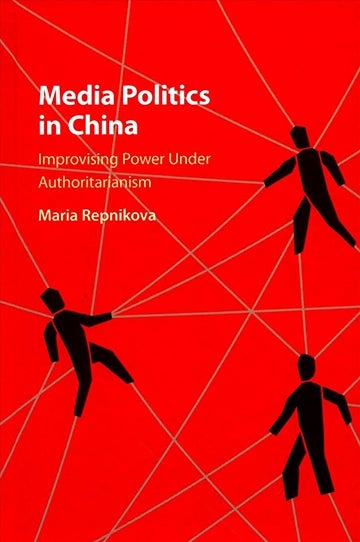
Who watches over the party-state? In this engaging analysis, Maria Repnikova reveals the webs of an uneasy partnership between critical journalists and the state in China. More than merely a passive mouthpiece or a dissident voice, the media in China also plays a critical oversight role, one more frequently associated with liberal democracies than with authoritarian systems. Chinese central officials cautiously endorse media supervision as a feedback mechanism, as journalists carve out space for critical reporting by positioning themselves as aiding the agenda of the central state. Drawing on rare access in the field, Media Politics in China examines the process of guarded improvisation that has defined this volatile partnership over the past decade on a routine basis and in the aftermath of major crisis events. Combined with a comparative analysis of media politics in the Soviet Union and contemporary Russia, the book highlights the distinctiveness of Chinese journalist-state relations, as well as the renewed pressures facing them in the Xi era.
View "Media Politics in China: Improvising Power under Authoritarianism"
Toby Miller and Marwan M. Kraidy, Wiley, 2016
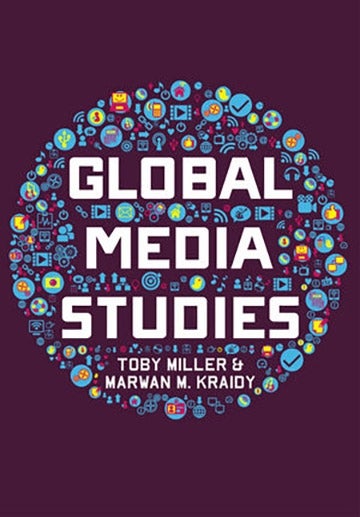
Global Media Studies is unique in its coverage of places, peoples, institutions, and discourses. Toby Miller and Marwan M. Kraidy provide a comprehensive how-to guide to the study of media, going far beyond the established English-language literature and drawing on the best methods and research from around the world. They look at political economy, global policymaking and governance, and the past and present manifestations of cultural imperialism.
In addition to providing a survey of the field, the book introduces a new form of textual analysis, with a special focus on reality television, as well as models of audience research. The authors include original analyses of the US, European, Latin American, and Arab worlds, and case studies of mobile telephony, the impact of US media, and reality television.
This original and uniquely global textbook will be an essential resource for students of global media and international communication.
Marwan M. Kraidy, Harvard University Press, 2016
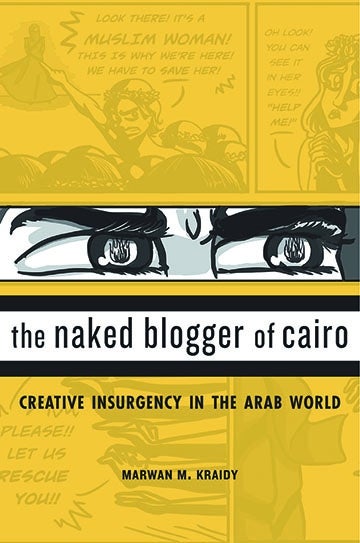
Uprisings spread like wildfire across the Arab world from 2010 to 2012, fueled by a desire for popular sovereignty. In Tunisia, Egypt, and Syria, protestors flooded the streets and the media, voicing dissent through slogans, graffiti, puppetry, videos, and satire that called for the overthrow of dictatorial regimes. Investigating what drives people to risk everything to express themselves in rebellious art, The Naked Blogger of Cairo uncovers the creative insurgency at the heart of the Arab uprisings. While commentators have stressed the role of social media, Marwan M. Kraidy shows that the essential medium of expression was not texting or Twitter but the human body. Brutal governments that coerced citizens through torture and rape found themselves confronted with the bodies of protestors. Activists challenged authority in brazen acts of self-immolation, nude activism, and hunger strikes. The bodies of dictators became a focus of ridicule. Syria’s Bashar al-Assad was rendered as a pathetic finger puppet, while Egypt’s Hosni Mubarak became a regurgitating cow. As Kraidy argues, technology publicizes defiance, but the body remains the vital nexus of physical struggle and digital communication, destabilizing distinctions between “the real world” and virtual reality, spurring revolutionary debates about the role of art, and anchoring Islamic State’s attempted hijacking of creative insurgency.
A 2016 Times Higher Education Book of the Year; 2017 Outstanding Book Award, International Communication Association; 2017 Best Book Award, Division Of Global Communication & Social Change, International Communication Association; 2017 Roderick P. Hart Outstanding Book Award, Political Communication Division, National Communication Association
View "The Naked Blogger of Cairo: Creative Insurgency in the Arab World"
Edited By Aswin Punathambekar and Shanti Kumar, Routledge, 2014
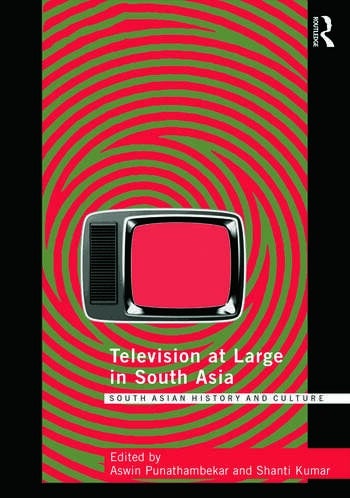
This book explores the empirical and theoretical significance of understanding television as a dynamic technology, a creative industry, and a vibrant cultural form that is "at large" in South Asia. Bringing together prominent scholars who have shaped television studies in South Asia, as well as emerging scholars who address new topics, this book decisively positions television as a key site in the study of South Asian History and Culture. In doing so, it also positions the study of television in South Asia and the South Asian diaspora as crucial in the rethinking of global television history and opens up new directions for the future of television studies. This volume will be essential reading for scholars and teachers of media and communication studies, media history, anthropology, and sociology, besides being of great interest to policymakers and media professionals.
This book was originally published as a special issue of South Asian History and Culture.
Aswin Punathambekar, NYU Press, 2013
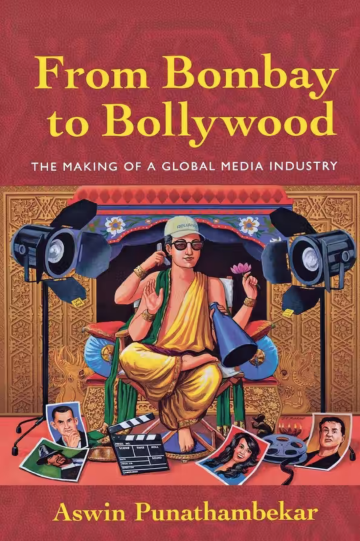
From Bombay to Bollywood analyzes the transformation of the national film industry in Bombay into a transnational and multi-media cultural enterprise, which has come to be known as Bollywood. Combining ethnographic, institutional, and textual analyses, Aswin Punathambekar explores how relations between state institutions, the Indian diaspora, circuits of capital, and new media technologies and industries have reconfigured the Bombay-based industry’s geographic reach. Providing in-depth accounts of the workings of media companies and media professionals, Punathambekar has produced a timely analysis of how a media industry in the postcolonial world has come to claim the global as its scale of operations.
Based on extensive field research in India and the U.S., this book offers empirically-rich and theoretically-informed analyses of how the imaginations and practices of industry professionals give shape to the media worlds we inhabit and engage with. Moving beyond a focus on a single medium, Punathambekar develops a comparative and integrated approach that examines four different but interrelated media industries--film, television, marketing, and digital media. Offering a path-breaking account of media convergence in a non-Western context, Punathambekar’s transnational approach to understanding the formation of Bollywood is an innovative intervention into current debates on media industries, production cultures, and cultural globalization.
View "From Bombay to Bollywood: The Making of a Global Media Industry"
Edited by Anandam P. Kavoori and Aswin Punathambekar, NYU Press, 2008
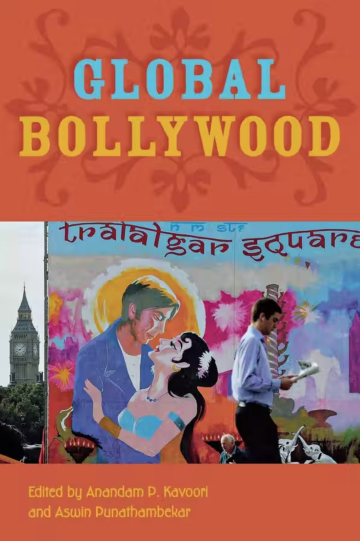
Bollywood is one of the most prolific film industries in the world. Based in Mumbai (formerly Bombay), the industry churns out hundreds of films each year—primarily melodramatic films with music and elaborately choreographed dance routines. Bollywood's popularity is quickly spreading across the globe, and, beyond the films themselves, Bollywood has made its way into global popular culture.
Global Bollywood brings together leading scholars to examine the transnational and transmedia terrain of Bollywood. Defining Bollywood as an arena of public culture distinct from Hindi-language Bombay cinema, this volume offers a new critical framework for analyzing the institutional, cultural, and political dimensions of Bollywood films and film music as they begin to constitute an important circuit of global flows in the twenty-first century.
Organized thematically, the book examines contestations surrounding the term “Bollywood,” changing relations between the state and the film industry, convergence with television and new media, online fan culture, film journalism, and the reception and negotiations of gender and sexuality in diverse socio-cultural contexts. Global Bollywood is indispensable for understanding not only Bollywood cinema and culture but also how global media flows are reconfiguring relationships among geography, cultural production, and cultural identity.
Podcast

Host: Juan Llamas-Rodriguez
Discussant: Martín Echeverría
Listen to podcast
Keywords: authoritarianism, memes, Mexico, political communication, political satire, YouTube
In this episode you will hear about:
- The affordances and limitations of YouTube for the political media ecosystem
- The role of memes in generating political interest among politically disinterested groups
- How people’s distrust of news organizations impact the communication environment for political news
- How restrictions on political speech have shifted in Mexico in the last few decades
Hosts: Anjali DasSarma and Sim Gill
Discussants: Natalie Fenton and Alison Hearn
Keywords: neoliberalism, higher education, artificial intelligence, community organizing
In this episode you will hear about:
- AI and job security
- How metrics, “publishing or perishing,” and intellectual extraction function under capitalism
- What the ideological project of hope offers us
- Community organizing, resistance, and learning
Hosts: Anjali DasSarma and Sim Gill
Discussants: Natalie Fenton and Alison Hearn
Keywords: neoliberalism, higher education, labor rights
In this episode you will hear about:
- How Fenton and Hearn define and understand the university within neoliberalism
- The material working conditions of faculty, students, and other laborers across UK, Canadian, and US contexts
- Unionizing and what it means to work as a collective
- The Research Excellence Framework and Higher Education Quality Council of Ontario
- Capitalism and the university as a corporation

Host: Zehra Husain
Author: Bishnupriya Ghosh
Book: The Virus Touch: Theorizing Epidemic Media (Duke UP, 2023)
In this episode you will hear about:
- The origins of the book and how Ghosh became interested in the body as a material medium
- The importance of conceptualizing global epidemics in multiscalar ways
- What Ghosh means by multispecies relationality and “lively media”
- The distinctions between the “global” and the “planetary”
- Ghosh’s research process for the book and her thoughts on using an ethnographic mode
- The media archive Ghosh assembled while conducting research for the book
- How and why Ghosh conceptualizes blood as media in the book
- The expansive sites, scales, and temporalities that Ghosh tracks across The Virus Touch
…and much more!
Listen to Global Media & Communication Podcast #012: The Virus Touch on New Books Network
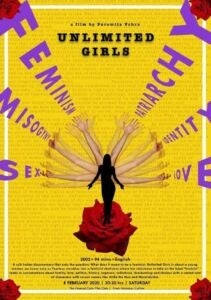
Host: Kinjal Dave
Guest: Paromita Vohra
Keywords: filmmaking, digital media, media industries, gender and sexuality, feminism, India
In this episode you will hear about:
- What inspired Paromita Vohra to pick up a camera
- The challenges of building and sustaining a career as an independent filmmaker
- Social, political, and cultural shifts in the India during the 1990s that informed Vohra’s media production
- How digital media technologies and the Internet shaped Vohra’s work
- How Unlimited Girls sought to capture a particular moment within a globalizing feminist discourse,
- How Vohra has rejected certain aesthetic and narrative paradigms to craft her own style and voice as an artist, straddling comedy, irony, and politically incisive commentary
- Vohra’s digital platform Agents of Ishq and the sense of community the project has built
- How to cultivate and encourage complex conversations about gender, sex, desire, and politics in the classroom
- Building intimacy with audiences and being vulnerable to criticism
- Vohra’s upcoming projects
…and more!
Listen to Global Media & Communication Podcast #011: Filmmaker, Artist, Writer on New Books Network
Host: Jing Wang
Author: Lin Zhang
Book: The Labor of Reinvention: Entrepreneurship in the New Chinese Digital Economy (Columbia UP, 2023)
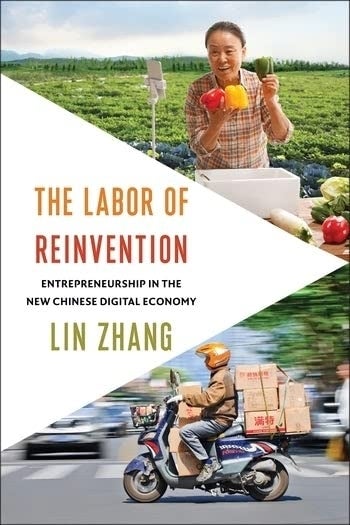
Keywords: Labor, Entrepreneurship, E-Commerce, Digital Platforms, Mutli-sited Fieldwork, Gender, China
In this episode you will hear about:
- A history of the book and Zhang’s entry into the fieldwork through family stories;
- How to understand entrepreneurialism as a dominant ideology in the global neoliberal labor economy and China’s positionality in the world;
- Why and how the book is organized based on three types of spaces – rural, urban, and transnational – across China and beyond;
- The similarities and differences between the elite and the grassroot entrepreneurs in Beijing;
- The e-commerce entrepreneurship as “platformized family production” in rural China and the roles played by government and large tech companies like Alibaba play in shaping the new rural production model;
- The limit and possibility of reinvention through “shanzhai” (copycat) e-commerce production;
- The gendered inequalities of entrepreneurial labor in rural and transnational spaces;
- What is “daigou” (personal shopping agents) in transnational e-commerce and the structural challenges entrepreneurs – especially women – face across national borders and digital platforms;
- What conversations in global studies of media and communication this book engages with.
Editor & Producer: Jing Wang
Listen to Global Media & Communication Podcast #008: The Labor of Reinvention on New Books Network
Host: Lucila Rozas
Author: Mary Beltrán
Book: Latino TV: A History
Keywords: Latino TV, Latinx identity, Cultural citizenship, Public Television, TV industry, Activism
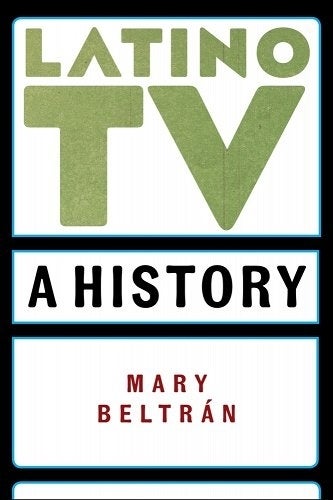
In this episode you will hear about:
- A brief trajectory of the book and the conversations on global studies of media and communication with which this book engages;
- The concept of cultural citizenship and its relevance to study Latino TV;
- How the author puts together the traces of the history of Latino TV, especially in the cases when it was difficult to find information about the series that were not preserved/archived;
- What has changed in the 2000s-2010s that led to the inclusion of more Latinx people in TV roles in front and behind the camera;
- How the diversification of latinidad identities in the TV shows is related to race, class, and gender through specific characters or forms of storytelling;
- The importance of Latino(a)(x) representation in the US TV industry and the potential limits of representation and visibility;
- The role of Latinx activism in the 1960s and 70s and the legacy of public television on today’s media landscape;
- Some recent developments on Latino TV after the publication of the book, particularly given the ongoing writers’ strike in streaming television.
Editor & Producer: Jing Wang
Listen to Global Media & Communication Podcast #007: Latino TV on New Books Network
Host: Ignatius Suglo
Author: Thomas Chen
Book: Made in Censorship: The Tiananmen Movement in Chinese Literature and Film (Columbia University Press, 2022)
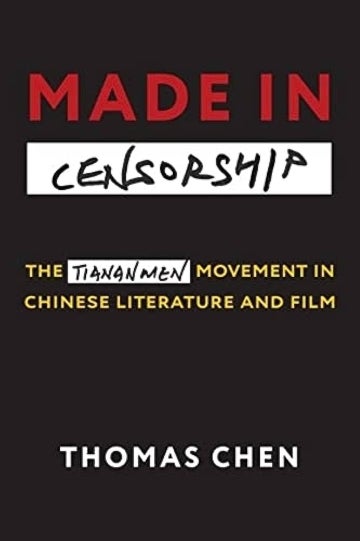
Keywords: Censorship, Literature, Film, Tiananmen, Media Event, Women, China
In this episode you will hear about:
- Author’s intellectual and professional trajectory that led him to the book;
- How to study Tiananmen Movement as a media event through a careful selection of literature and film materials;
- How to think of the productivity of silence and absence;
- The use of “positive energy” in mobilizing censorship;
- Human labor and the idea of “workshop” in the work of censorship;
- How iconic images such as “Tank Man” have been interpreted and appropriated;
- The role played by women in social movements and their representations in post-1989 China;
- The emergence of Internet in the 1990s and the paradoxical nature of “Internet sovereignty”;
- Author’s positionality and reflection on writing the book.
Editor & Producer: Jing Wang
Listen to Global Media & Communication Podcast #006: Made in Censorship on New Books Network
Host: Sim Gill
Author: Jonathan Gray
Book: Dislike-Minded: Media, Audiences, and the Dynamics of Taste (NYU Press, 2021)
Keywords: Dislike, audience studies, media cultures, identity, representation, citizenship
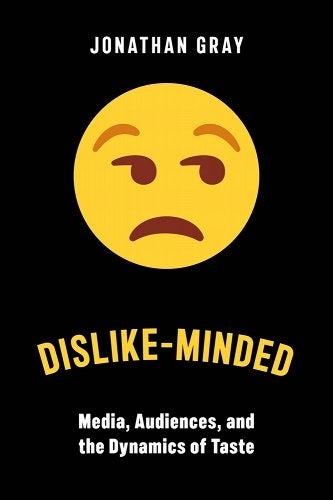
In this episode you will hear about:
- A brief history of the book and its connection to global studies of media and communication;
- The role of media and cultural studies in amplifying the voices of dislikers, and how can scholars in these fields better understand and appreciate the register of dislike;
- The method of refractive audience analysis as a way to understand how adaptations of media texts affect people's perceptions of the original texts;
- How paratexts can shape audience perceptions and understanding of a media product;
- How the gendered norms may hinder women from expressing dislike, and how this relates to larger cultural systems of dislike, including political contexts;
- Some recent developments that have added to or changed the initial arguments/findings in the book.
Editor & Producer: Jing Wang
Listen to Global Media & Communication Podcast #005: Dislike-Minded on New Books Network
Host: Yuval Katz
Author: Herman Wasserman
Book: Ethics of Engagement: Media, Conflict and Democracy in Africa (Oxford UP, 2020)
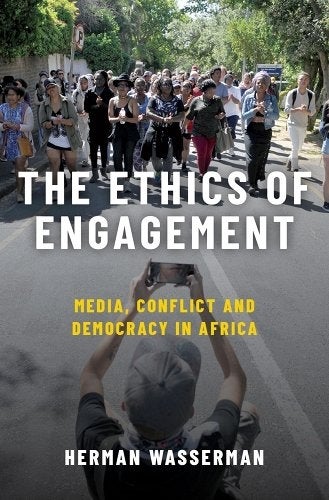
Keywords: Africa, Agonism, Democratization, Journalism Studies, Listening, Media Ethics, Peace
In this episode you will hear about:
- The ethical and methodological challenges of studying media in Africa;
- Why democratization is not a linear process;
- What tools journalists have at their disposal to support processes of democratization;
- Reflections on the professional conduct of journalists and what they can do to be more attentive to the needs of ordinary people;
- Why conflicts are not necessarily detrimental to democracy;
- Some tips and advice for early career scholars studying the Global South.
Editor & Producer: Jing Wang
Listen to Global Media & Communication Podcast # 006: The Ethics of Engagement on New Books Network
Hosts: Aswin Punathambekar and Jing Wang
Authors: Thomas Poell, David B. Nieborg, and Brooke Erin Duffy
Book: Platforms and Cultural Production (Polity 2021)

Keywords: Platforms, Cultural Production, Social Media, Game Industries, Journalism, Governance, Labor, Creativity, Authenticity, Citizenship
In this episode you will hear about:
- How this collaborative project came about, given each of the authors has distinct interests and disciplinary orientations;
- Given the two keywords of “platforms” and “cultural production,” how did the authors make sense of these keywords in relation to broader processes of digital infrastructures and imaginaries;
- How three key sections – social media, games, and journalism – were identified by the authors to explain the idea of “platformization”;
- How the platforms work as multi-sided markets and the approaches to account for the dynamism and lifecycles at work in platform economies;
- A discussion of Twitter as a useful case of platformization to grasp the challenges of platform governance;
- Why the authors chose to specifically focus on the role and agency of cultural producers;
- How to study cultural practices in various platforms across a wide variety of sociopolitical contexts in both Global North and South;
- The structural inequalities of platform economies, the precarity of the platform-dependent labor market, and the efforts of cultural producers to face insecurity;
- The cultural meanings of “creativity” and “authenticity” and the tension between the profit-driven platform logic and the individual search for belonging in social media such as TikTok;
- The relevance of cultural production and platforms to understanding the present and future of democratic governance and civic life in the post-truth era;
- The next collaborative project, such as a second volume, conferences, and research networks.
Editor & Producer: Jing Wang
Host: Juan Llamas-Rodriguez
Authors: Lilie Chouliaraki and Myria Georgiou
Book: The Digital Border: Migration, Technology, Power (NYU Press, 2022)
Keywords: Digital border, migration, technology, power, social media, journalism, securitization, representation, crisis, humanitarianism, human rights
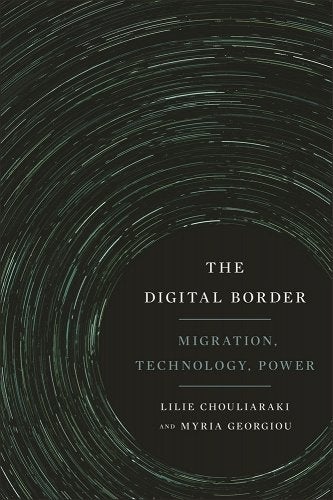
In this episode you will hear about:
- What The Digital Border is about, its importance, and its implication;
- How the authors’ previous works helped build the foundation for writing this book collaboratively;
- Why and how the authors chose to focus on specific forms of media such as social media and journalism;
- A discussion of humanitarian securitization vis a vis entrepreneurial securitization;
- How to understand the theoretical shift from the “crisis of migration” to the “crisis of responsibility”;
- How do we contend the different temporalities of resistance as various actors produce or respond to border technologies and infrastructures;
- As the displacement of people are intensifying, what frameworks and toolkits can be useful for us to rethink global migration against the “crisis of imaginary” (imaginary as a representational framework that people normatively think about certain issues);
- What are the futures of globalization and its counter movements in Global North from the perspectives of migration and bordering;
- What are the areas the authors wish to further explore in the future.
Editor & Producer: Jing Wang
Listen to Global Media & Communication Podcast #004: The Digital Border on New Books Network
Host: Florence Madenga
Author: Julia Ticona
Book: Left to Our Own Devices Coping with Insecure Work in a Digital Age (Oxford University Press, 2022)
Keywords: Gig economy, digital inequality, precarity, platform economy, digital hustle, gendered labor, care work
In this episode you will hear about:
- Dr. Ticona’s intellectual trajectory and how her first monograph has been transformed from a dissertation project into a book;
- What audience the book is intended for and what critical scholarship means for the author;
- The design of the research project and the processes and ethics of conducting research about the gig economy;
- How the ongoing pandemic has changed or altered the way Dr. Ticona thinks about this book;
- The core arguments and take-away points from the book around keywords such as “digital inequality,” “precarity,” “platform economy,” and “digital hustle;”
- The global implications of a study on low-wage gig economy workers in the American labor market;
- The question of agency in workers’ everyday life and how people survive in the global platform economy;
- The gendered nature of labor in the gig economy and what Dr. Ticona calls “tethered care work;”
- How we can better understand the complexity of our mediated worlds and precarious work beyond the tech companies and digital platforms.
Editor & Producer: Jing Wang
Listen to Global Media & Communication Podcast #003: Left to Our Own Devices on New Books Network
Host: Mariela Morales Suárez
Author: Larisa Kingston Mann
Book: Rude Citizenship: Jamaican Popular Music, Copyright, and the Reverberations of Colonial Power (UNC Press, 2022)
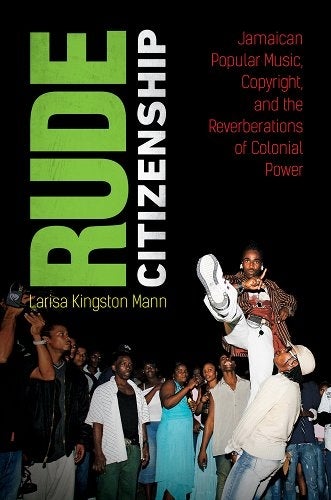
In this episode you will hear about:
- Dr. Mann’s intellectual trajectory and how she became interested in the topic of copyright in Jamaican popular music;
- The concept of “rude citizenship” through the Jamaican music world;
- What it means to be “original” from the perspective of copyrights, language, and diverse modes of cultural production in Jamaica;
- Dr. Mann’s writing process as a form of translation from fieldwork notes, archival materials, and music contents into ethnography;
- How to make the classroom a meaningful pedagogical space by learning from marginal voices and practices;
- What constitutes the exilic spaces, namely, the reimagining of marginalized spaces as sites of agency and sovereignty through music and cultural production;
- The transnational networks of the local music production in Jamaica and global flows of sonic resistance, especially during COVID-19.
Editor & Producer: Jing Wang
Listen to Global Media & Communication Podcast #002: Rude Citizenship on New Books Network
Host: Aswin Punathambekar
Author: Samhita Sunya
Book: Sirens of Modernity: World Cinema via Bombay (U California Press, 2022)
Keywords: #cinema #film #1960s #SouthAsia #HindiFilm #Bombay #Love #Gender
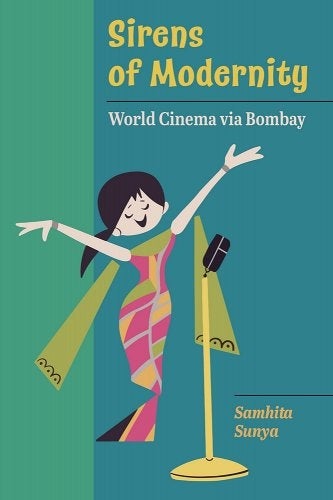
In this episode you will hear about:
- Dr. Sunya’s intellectual trajectory in studying South Asian cinema from Houston to Bangalore, Bombay, and beyond;
- How the periodization of the “long” 1960s – bookended by the 1955 Bandung Afro-Asian Conference and the 1975 Indian Emergency – comes into view through the author’s interdisciplinary approach;
- How Dr. Sunya works her way through and out of a popular binary misunderstanding of Indian cinema - a familiar opposition between an auteurist world cinema and song-and-dance driven popular cinema;
- Why the author chooses what would be considered oddball or off-beat media artifacts, what kinds of sources she gathers in relation to these materials, and where she looks for them in creative ways;
- Reflection upon the pedagogy of world cinema in the classroom;
- A discussion of the notion of “excess” and how it is weaved into the three central themes – love, desire, and gender – that emerge throughout the book;
- How Dr. Sunya’s cross-industry and trans-regional perspective counter the spatial biases that are deeply ingrained into the disciplinary boundaries;
- A reflection on the nature of academic work through the lens of “love” on topics like world cinema and South Asia.
Editor & Producer: Jing Wang
Original Background Music by Mengyang Zoe Zhao
Listen to Global Media & Communication Podcast #001: Sirens of Modernity on New Books Network
Papers & Briefs
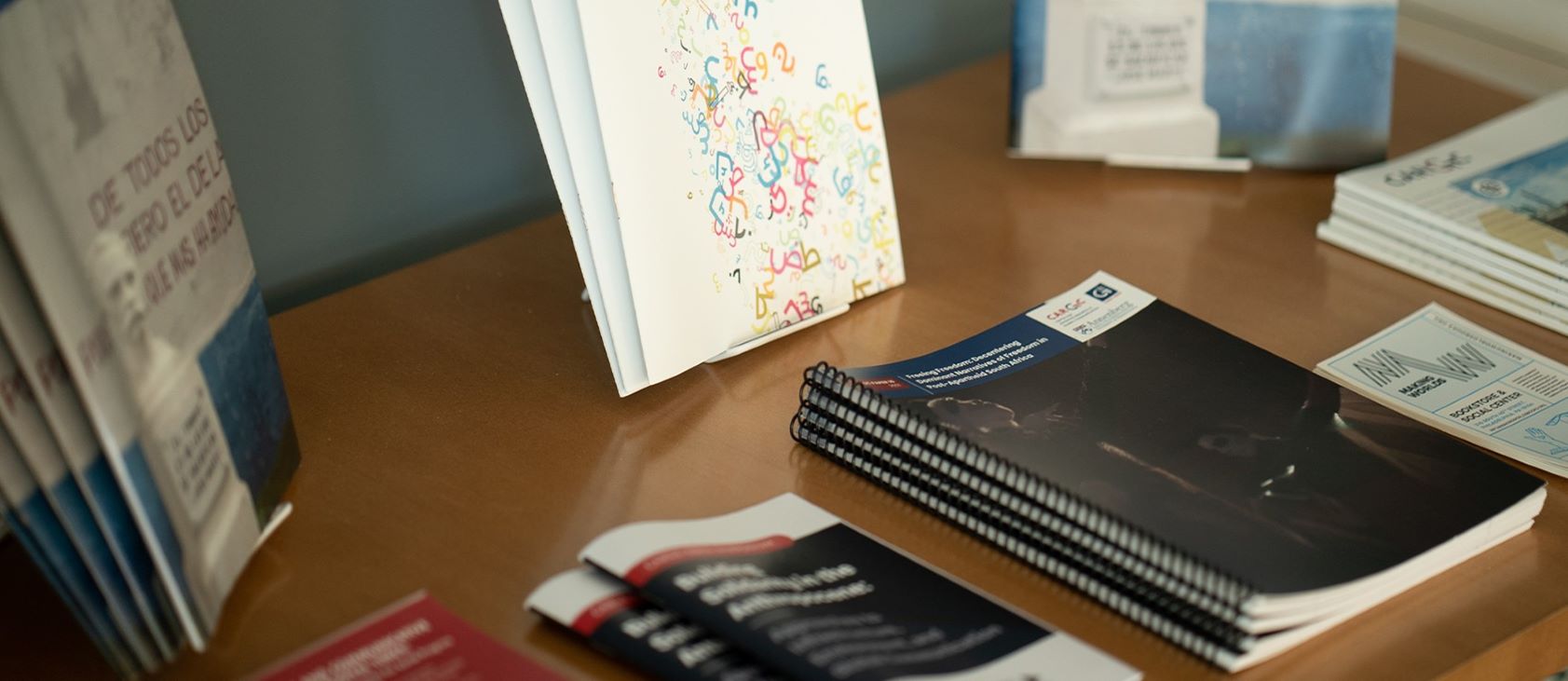
Sudeep Bhargava
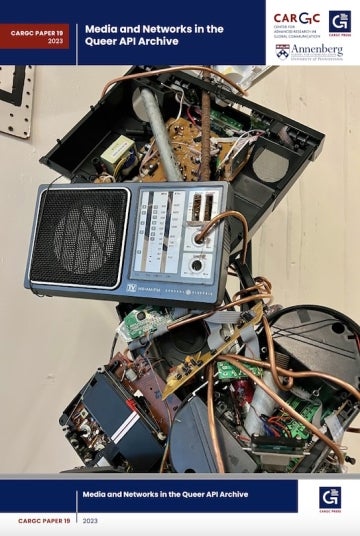
At the neglected intersection of progressive political movements, queer-identifying Asian/Pacific Islanders are denied access to institutional and community support. The current study examines the social networks and relationships of queer Asian/Pacific Islanders involved in community organizing in the city of Philadelphia to determine how they seek out and secure forms of support otherwise unavailable to them. Knowledge production and information sharing in the social and support networks built by queer API communities are often supported by media and the use of digital communication technologies and constitute a novel form of the queer archive. Semistructured in-depth interviews with community members and organization leaders were conducted alongside observational studies at community-centered events. Participants narrated about their expansive, and often interconnected, networks of individuals and organizations from which they received support. These networks are often built and experienced through communication technologies and digital platforms, allowing community members to reconfigure their networks to best fit their needs; though, these shifting networks are subject to constant negotiation and mediation and can even become unsafe at times. Notably, participants specified ways in which these relationships had shifted in light of the COVID-19 pandemic. This study thus proposes that community organizations constitute an “archive of relationships,” in which the relationships which subjects’ social networks are comprised of play the archival function of information-sharing and storing as well as producing new knowledge and defining new realities. This study contributes to the fields of archival and network research, proposing a need for the two to be examined alongside each other, widely expanding the definition of the archive.
Fernanda R. Rosa
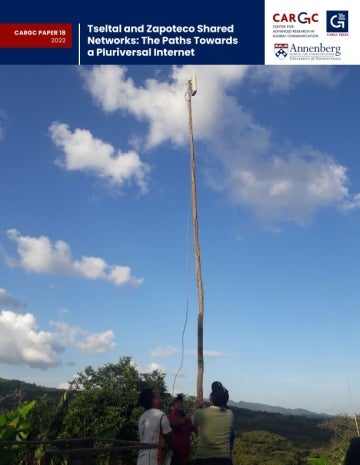
In CARGC Paper 18, Fernanda R. Rosa explores the Indigenous networks, principles, and practices of internet infrastructure building and sharing in Tseltal and Zapoteco sovereign territories in Chiapas and Oaxaca, Mexico. She uses the concept of shared networks to examine “the first mile signal-sharing practices” (p.8) among these underserved Indigenous communities and highlight their active participation in designing their own first mile infrastructure as “internet codesigners” (p.8). The paper draws on extensive fieldwork that Rosa conducted in 2017 among different institutions and actors in Chiapas and Oaxaca, two states with the lowest Internet connectivity rates in Mexico, and reveals it is the local community members, rather than the big internet service providers (ISP), that truly drive the first mile internet connection.
Read "Tseltal and Zapoteco Shared Networks: The Paths Towards a Pluriversal Internet" in English
Read "Tseltal and Zapoteco Shared Networks: The Paths Towards a Pluriversal Internet" in Spanish
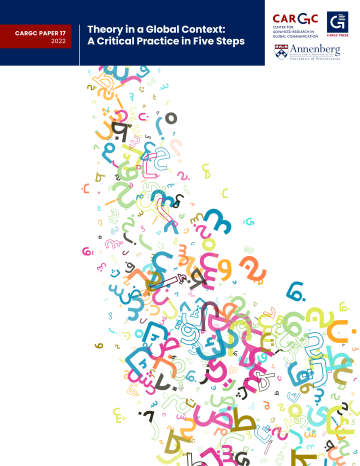
Tarek El-Ariss
Originally delivered as the 2021 CARGC Distinguished Lecture in Global Communication, CARGC Paper 17 historicizes and situates theory in a global context, approaching it as an intellectual tradition that has produced powerful critiques of normativity and decentered text, image, and genealogy. In this paper, Professor Tarek El-Ariss revisits his intellectual trajectory and scrutinizes his engagement with critical theory. Reflecting on his personal journey as a scholar, writer, and critic in this article, he delineates five stages of critical practice in his encounters with theory, comparative literature, and Middle Eastern studies. These five stages are: a critique of representation, occupy the canon, impasse and breakdown, cross-disciplinary sublime, and new writing genres. By offering a wide-ranging and insightful overview of the five-stage theoretical practice in this paper, Professor El-Ariss addresses some of the questions and ethical imperatives that we need to raise as an intellectual community today in order to develop new critical practices, writing genres, and forms of communication that operate at both local and global levels.
Read "Theory in a Global Context: A Critical Practice in Five Steps"
Toni Walker
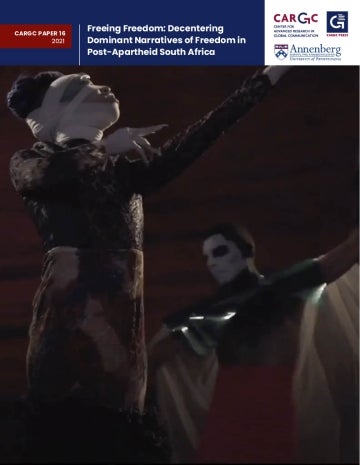
This paper examines the continuous struggle over meanings of freedom in post-apartheid South Africa particularly for marginalized communities. It came as a result of the research project that Toni Walker pursued during her undergraduate fellowship at CARGC. In March 2020, she took a twelve-day research trip to Cape Town and Johannesburg to interview South African Black women, nonbinary, and self-identifying queer artists and visit the neighborhoods, art galleries, and cultural centers where these artists live and work. Through a careful and sensitive analysis of six multimedia pieces enriched with insights from her interviews with the artists, Toni Walker highlights the meanings of freedom that emerge when these artists are centered. CARGC Paper 16 not only situates culture and lived experiences as important focal points for navigating meanings of freedom, but it also argues that some of the most expansive meanings of freedom can be found in the cultural expressions of marginalized Black creators.
Read "Freeing Freedom: Decentering Dominant Narratives of Freedom in Post-Apartheid South Africa"
CARGC Special Report
Sara García Santamaría
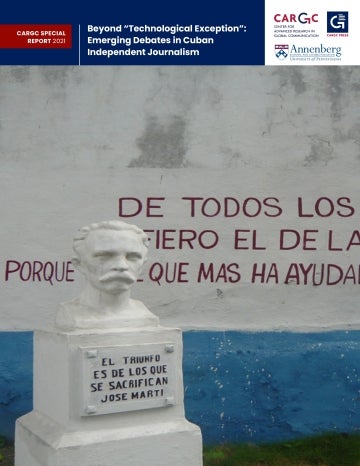
This report examines the latest developments in the emergent wave of Cuban independent journalism, taking a special look at the impact of both digital technologies and recent regulation. As access to the Internet and digital technologies has increased, it has changed what it means to be a citizen and a journalist, on the Island. Attempts to convince journalists that a change from within the system is not only possible, but also more stable for the country, have been pervasive since the mid-1970s and have managed to deter journalists from looking for change outside the institutional channels. However, for some Cuban journalists this view has been changing in the last decade. The report consists of sections that analyze the impact of digital technologies on citizens’ life and on independent journalism, the intersection between legitimacy and legality in Cuban independent journalism, the consequences that a lack of “official” legitimacy and legality have on journalists’ careers, and the ways they have found to reassert their right to exist. The goal of this report is to stress the levels of complexity that traverse current transformations in the Cuban mediasphere and acknowledge that, growing up within the system, it is not straightforward for young journalists to break away from it. Such complexity needs to be taken into account if we want to go beyond binary and simplistic accounts of the contemporary Cuba.
Giang Nguyen-Thu
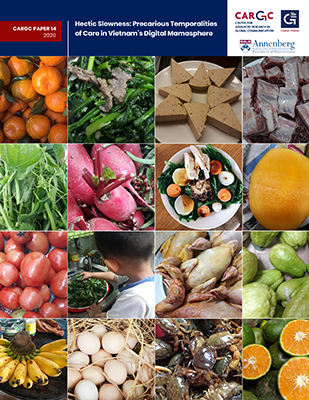
CARGC Paper 14, “Hectic Slowness: Precarious Temporalities of Care in Vietnam’s Digital Mamasphere,” by Giang Nguyen-Thu explores the temporal entanglements of care and precarity in Vietnam by unpacking the condition of “hectic slowness” experienced by mothers who sell food on Facebook against the widespread fear of dietary intoxication. Crafted during Nguyen-Thu’s CARGC Postdoctoral Fellowship, originally presented as a CARGC Colloquium, and drawing on thirty months of ethnographic fieldwork with Vietnamese mothers, CARGC Paper 14 paper offers an incredibly nuanced and fine-grained engagement with the everyday digital practices of Vietnamese mothers and grandmothers in cities such as Hanoi. This grounded attention to digital life and motherhood is, then, entered in productive dialogue with feminist and media scholarship in order to build a rich analysis that challenges our continued reliance on Western-centric notions such as autonomy to make sense of care, mothering, and media practices.
Read "Hectic Slowness: Precarious Temporalities of Care in Vietnam’s Digital Mamasphere"
Stanislav Budnitsky
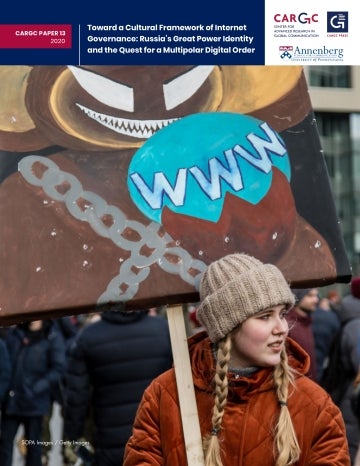
CARGC Paper 13, “Toward a Cultural Framework of Internet Governance: Russia’s Great Power Identity and the Quest for a Multipolar Digital Order,” by CARGC Postdoctoral Fellow Stanislav Budnitsky was initially delivered as a CARGC Colloquium in 2018. As part of Budnitsky’s larger research project on the relationship between nationalism and global internet governance, CARGC Paper 13 considers the cultural logics underlying Russia’s global internet governance agenda. It argues that to understand Russia’s digital vision in the early twenty-first century and, by extension, the dynamics of global internet politics writ large, scholars must incorporate Russia’s historic self-identification as a great power into their analyses.
Saskia Sassen, Columbia University
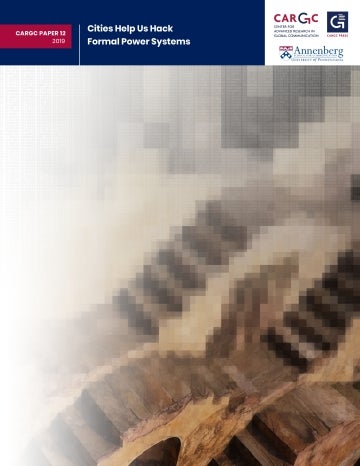
Initially delivered as the 2017 CARGC Distinguished Lecture in Global Communication, CARGC Paper 12 presents an analysis of cities as complex, diverse, and incomplete systems. For Sassen, it is precisely these features of urban forms – their complexity, diversity and incompleteness – that offer the possibility of a new type of politics, centered on new types of political actors. She is particularly interested in two features of global cities: their presence as strategic frontier zones where actors from different worlds can meet without clear rules of engagement and their strategic importance for hacking old orders.
Julia Becker
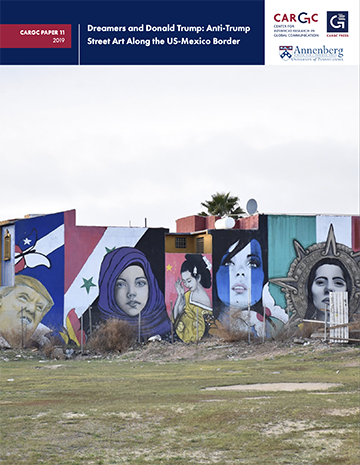
What tools are at hand for residents living on the US-Mexico border to respond to mainstream news and presidential-driven narratives about immigrants, immigration, and the border region? How do citizen activists living far from the border contend with President Trump’s promises to “build the wall,” enact immigration bans, and deport the millions of undocumented immigrants living in the United States? CARGC Paper 11, “Dreamers and Donald Trump: Anti-Trump Street Art Along the US-Mexico Border,” answers these questions through a textual analysis of street art in the border region, examining Donald Trump’s rhetoric about immigration, and analyzing how street art situated at the border becomes a medium of protest in response to that rhetoric.
Read "Dreamers and Donald Trump: Anti-Trump Street Art Along the US-Mexico Border"
Yara M. Damaj, Michael Degerald, Kareem El Damanhoury, Katerina Girginova, Rowan Howard-Williams, Brian Hughes, Mohammed Salih, John Vilanova, and William Youmans
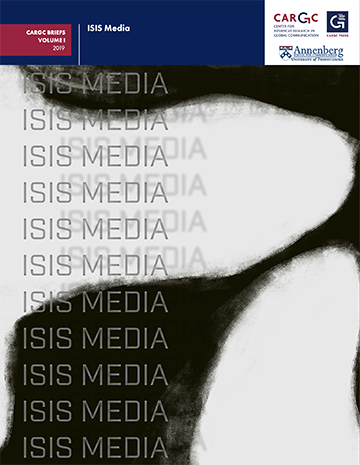
The essays that comprise CARGC Briefs Volume I: ISIS Media began their lives as presentations at a small, by-invitation workshop, “Emerging Work on Communicative Dimensions of Islamic State,” held on May 3-4, 2017 at the Center for Advanced Research in Global Communication at the Annenberg School for Communication. Consistent with CARGC’s mission to mentor early-career scholars, the workshop was a non-public event featuring graduate students, some affiliated with the Jihadi Networks of Communication and CultureS (JINCS) research group at CARGC, and others from around the United States and the world, in addition to postdocs and faculty members. Parameters were purposefully broad to encourage independent thought and intellectual exploration: contributors were asked to write short essays focusing on any single aspect of Islamic State that was part of their research. The result is a group of fascinating essays: using mostly primary sources (textual, visual, or audio-visual), examining several media platforms and modalities, considering multiple levels of theoretical deployment and construction, and shedding light on various aspects of Islamic State communication against the broad back drop of history, ideology, and geopolitics, the following include some of the most innovative approaches to Islamic State to date, and promise a wave of fresh voices on one of the most important challenges to global order.
Bülay Doğan
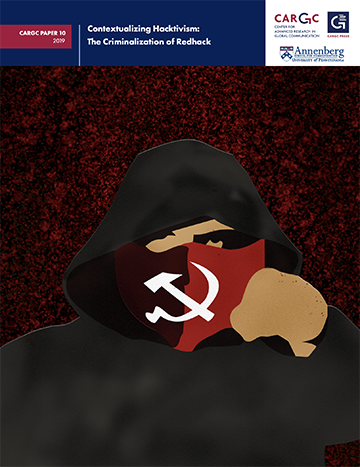
Through an empirical examination of the criminalization of the Turkish hacktivist group Redhack in social, legal, and cultural discourses, CARGC Paper 10 — “Contextualizing Hacktivism: The Criminalization of Redhack” by Bülay Doğan — explores the critical conflation of hacktivism with cyber-terrorism that enables states to criminalize non-violent hacktivist groups.
Read "Contextualizing Hacktivism: The Criminalization of Redhack"
Samira Rajabi
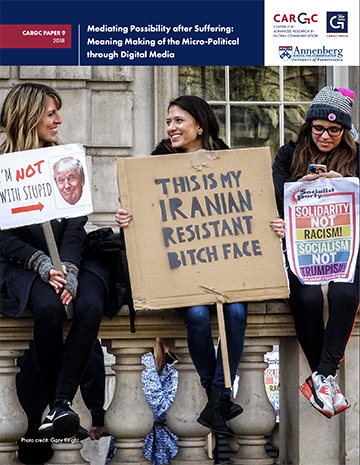
CARGC Paper 9, “Mediating Possibility after Suffering: Meaning Making of the Micro-Political through Digital Media,” by CARGC Postdoctoral Fellow Samira Rajabi, is based on Rajabi’s 2018 CARGC Colloquium. Using three empirical case studies from Instagram, Rajabi examines the Trump administration’s 2017 travel ban as a traumatic experience and its digital mediation. First exploring a general understanding of trauma as it relates to global media studies, she then develops the notion of “symbolic trauma” to understand how Iranian-Americans mediated the travel ban’s effects.
Rayya El Zein
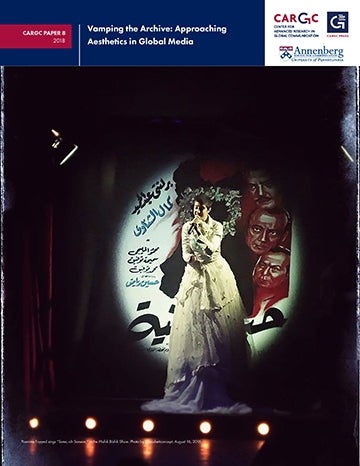
CARGC Paper 8, “Vamping the Archive: Approaching Aesthetics in Global Media,” by CARGC Postdoctoral Fellow Rayya El Zein, is based on El Zein’s CARGC Colloquium and draws its inspiration from Metro al-Madina’s Hishik Bishik Show in Beirut. CARGC Paper 8 weaves assessments of local and regional contexts, aesthetic and performance theory, thick description, participant observation, and interview to develop an approach to aesthetics in cultural production from the vantage of global media studies that she calls “vamping the archive.”
Read "Vamping the Archives: Approaching Aesthetics in Global Media"
Christopher Ali
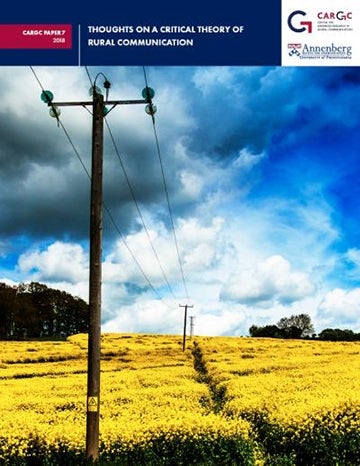
CARGC Paper 7 begins with the provocative question, “What Does It Mean to Be Rural?” In answering this question and taking up the difficult task to “theorize the rural,” former CARGC fellow Christopher Ali drew on critical scholarship in media and communication studies, political economy, critical geography, phenomenology, and mobility studies to point the way forward for a critical theory of rural communication. He argues that understanding the rural is essential to understanding the dynamics of our globalized and networked world.
Mariela Morales Suárez
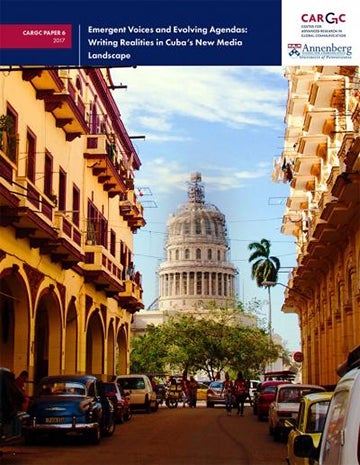
Drawn from Morales Suárez’s Penn Honors Thesis about the evolution of the Cuban media landscape, and developed during her CARGC Undergraduate Fellowship, CARGC Paper 6 presented findings from an empirical study of Cuban journalists, their decision-making practices, the motivations that drive them, the challenges they face, and the opportunities they crave. Morales Suárez conducted in-depth, semi-structured interviews with a group of independent Cuban journalists recruited from twenty non-governmental publications during the spring of 2017.
Read "Emergent Voices and Evolving Agendas: Writing Realities in Cuba’s New Media Landscape"
Mimi Sheller
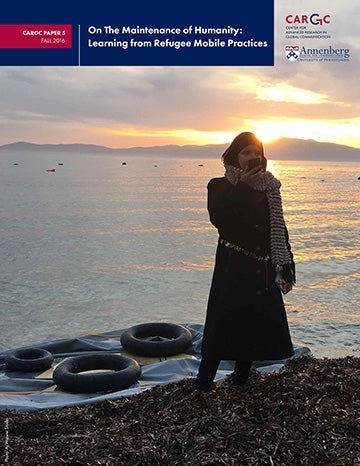
This CARGC Paper drew on Sheller’s Distinguished Lecture and presented a project in collaboration with Chinese artist Ai Weiwei and French curator Guillaume Logé. For many refugees, smartphones have become their most valuable asset. While theories of migration have long spoken of the “double absence” of migrants (both from their country of origin and from their host country), Sheller identified that certain researchers now allude to the “double presence” made possible by ICT. This paper explored the increasingly intrinsic overlap between physical and virtual mobility.
Read "On the Maintenance of Humanity: Learning from Refugee Mobile Practices"
Arjun Appadurai
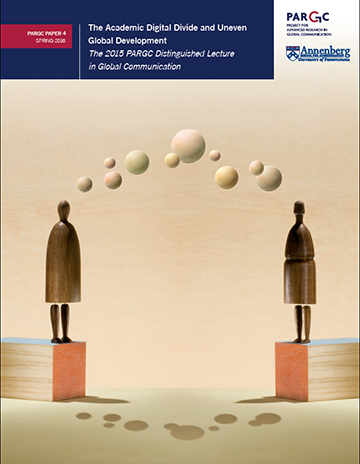
CARGC Paper 4 reprinted Appadurai’s October 2015 Distinguished Lecture at PARGC. In it, he warned against the dangers of “knowledge-based imperialism and scholarly apartheid” and offered possible ways to avoid them. Appadurai identified a growing rift between media studies and communication studies, with scholars concerned with institutions, power, resources, and large-scale data on one side, and scholars concerned with interpretation, texts, languages, and images on the other. Yet, despite the history of this divide, in CARGC Paper 4, Appadurai outlined what we can do to close the growing distance between media and communication studies.
Read "The Academic Digital Divide and Uneven Global Development"
Maria Repnikova
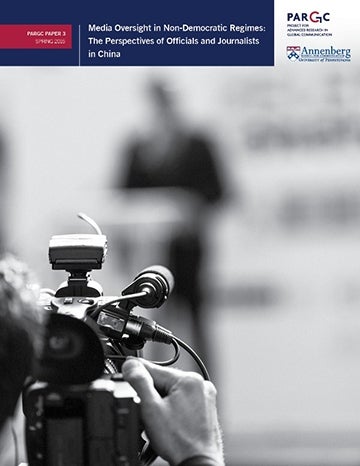
CARGC Paper 3 grew out of Repnikova’s 2014 Postdoctoral Fellow Colloquium. In it, Repnikova rebuked a popular projection in comparing media landscapes based on a binary vision of free versus not free and objectivity versus propaganda. The frequent focus of Western media on censorship in authoritarian regimes, Repnikova argued, highlights the gap between media practices in democratic and non-democratic contexts. Challenging these conceptions, CARGC Paper 3 examined a journalism practice generally associated with democratic contexts—investigative reporting—in a regime most renowned for censorship and pervasive propaganda—contemporary China.
Donatella Della Ratta
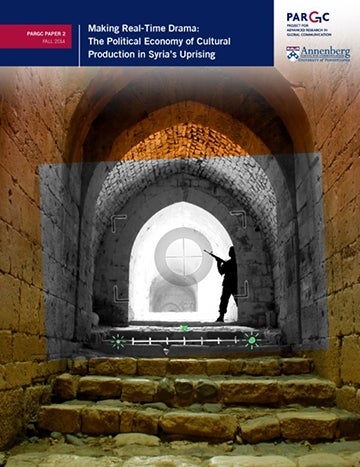
In CARGC Paper 2, Della Ratta explored how one 2013 Syrian television serial, Wilada min al-Khasira [Birth from the Waist] responded in real time to unfolding events of the Syrian revolution. She argued that the serial offers a living site for scholarly reflection on how cultural production and the power relations that shape it might shift, recombine, and adapt in the context of the three-year-old uprising turned into an armed conflict. Della Ratta mobilized the television serial to explore how the geopolitical relationships between Syrian and Gulf political elites had been dramatically reconfigured.
Read "Making Real-Time Drama: The Political Economy of Cultural Production in Syria’s Uprising"
Michael Curtin
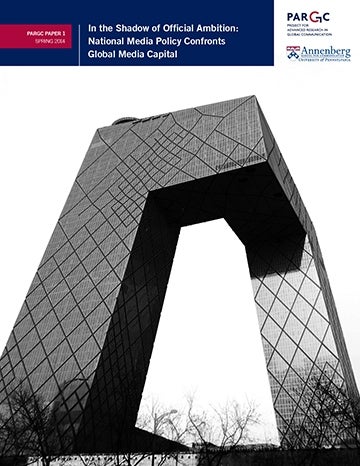
CARGC Paper 1 drew on Curtin’s then book project, Media Capital, which compares and contrasts cities that have become centers of the global film and television industries, such as Bombay, Lagos, and Miami. In the paper, Curtin explored the implications of Chinese cultural policy within the broader context of media globalization, providing a framework for understanding the logics of media capital and the challenges confronting national governments, making comparisons to Arab, African, and Indian media, and reflecting on the prospects for creativity and diversity in film and television.
Read "In the Shadow of Official Ambition: National Media Policy Confronts Global Media Capital"
Special Issues
International Journal of Communication, Volume 14, April 2020
Co-Editors: Marwan M. Kraidy & Marina R. Krikorian
How does the group that calls itself “Islamic State” communicate? How has Islamic State been understood and contested? This Special Section gathers emergent scholarly voices, many deploying humanistic inquiry, to probe a phenomenon that has predominantly been the province of social scientists, to explore and understand the players, patterns, and practices that have mediated Islamic State: the communicative ways in which the group has been studied, reported on, visualized, narrated, mocked, spoofed, and resisted. We use “mediation” rather than “media” to shift public discourse on Islamic State beyond the focus on technology that has characterized research on media and sociopolitical change generally, and Islamic State communication in particular. We seek to understand the historical, ideological, technological, and cultural complexity of Islamic State, meshing translocal struggles with global geopolitics. Mediation connotes a broad approach to media, which includes words, images, bodies, platforms, and the expressive capacities and meaning-making practices that communicators generate when they deploy these media.
Communication and the Public, Volume 2, Issue 2, June 2017
Co-Editors: Marwan M. Kraidy & Marina R. Krikorian
A comprehensive picture of dissent in the Arab uprisings requires an understanding of how revolutionaries have represented themselves and how various media, digital and otherwise, were incorporated in these communicative processes. Together, the articles in this Special Issue focus on the myths, ideologies, and histories that inspired slogans, murals, and poems of pointed social relevance and political potency. Originally presented at the inaugural biennial symposium of what was then the Project for Advanced Research in Global Communication in 2014, these papers explore the creative permutations of symbols, words, images, colors, shapes, and sounds that revolutionaries deployed to contest despots, to outwit each other, to attract attention, and to conjure up new social and political imaginaries. The issue exemplifies one of the fundamental principles undergirding the institutional mission of the Center for Advanced Research in Global Communication: a robust dialogue between theoretical advances on one hand, and deep linguistic, cultural, historical knowledge of the world region under study, on the other.
Read "The Revolutionary Public Sphere: The Case of the Arab Uprisings"
International Journal of Communication, Volume 11, 2017
Editor: Marwan M. Kraidy
In the 1980s and 1990s, the question “Is there a global culture?” fueled heated debates as intellectual opponents debated the social, political, economic, and cultural consequences of globalization. Guest-edited by Marwan M. Kraidy, this Special Section of the International Journal of Communication by global communication scholars revisits the discussion on global culture in light of the digital revolution. Originally presented at CARGC’s second Biennial Symposium in April 2016, these articles do not pretend to provide a comprehensive answer to the existence or lack thereof of a global digital culture. Rather, they consider this question as an intellectual provocation to revisit how the universal relates to the particular, the global to the local, the digital to the material. Questions guiding these articles include: How do networks transmute individual autonomy and the sovereignty of the body? How is digital culture fomenting disjuncture across the globe in dissident, marginal, or rogue formations? How is the digital affecting the ways people work and play, how they experience and judge beauty, and how they protest? Most fundamentally, does digitization herald a new chapter in how we understand ourselves?
Read "Convergence and Disjuncture in Global Digital Culture"
